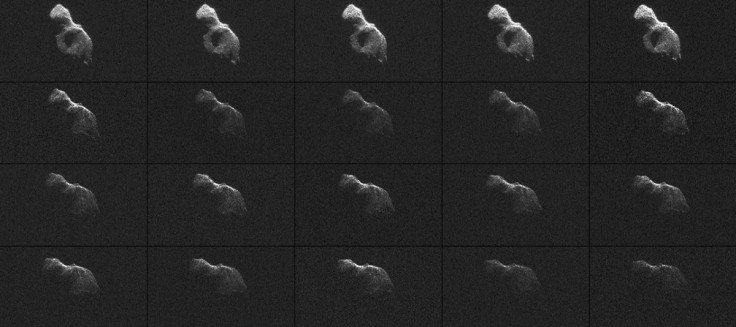Asteroid 2014 HQ124: Nasa Captures Images of 'The Beast' Whizzing Past Earth
Nasa has captured incredible views of the recent near-Earth asteroid 2014 HQ124, nicknamed 'The Beast', as it flew past our planet.
Captured on 8 June, the pictures are some of the most detailed radar images of a near-Earth asteroid ever obtained, using two giant telescopes.
Researchers at Nasa's Jet Propulsion Laboratory (JPL) in California worked with a team at the Arecibo Observatory in Puerto Rico to capture the striking images.
"These radar observations show that the asteroid is a beauty, not a beast," said Alessondra Springmann, a data analyst at the Arecibo Observatory, as reported by NBC News.
The radar images, acquired using Arecibo's 1,000-foot-wide dish in Puerto Rico and the 230-foot Goldstone DSS-14 antenna at the JPL, show that 2014 HQ124 is a long, irregular object. It appears to be at least 1,200 feet-wide and spins on its axis around every 20 hours.
"This may be a double object, or 'contact binary,' consisting of two objects that form a single asteroid with a lobed shape," said Lance Benner, of Nasa's JPL.

According to Universe Today, around one in six near-Earth asteroids have this elongated of "peanut" shape.
The two telescopes were combined to see the detail in radar reflections, where most ground-based telescopes would only see a point of light. New equipment in Puerto Rico made it possible to use Goldstone's superior resolution with Arecibo's greater sensitivity.
Astronomers used the Deep Space Network antenna at Goldstone to beam radar signals at the asteroid which reflected them back to the larger Arecibo dish in Puerto Rico. The technique greatly increases the amount of detail visible in radar images.
"By itself, the Goldstone antenna can obtain images that show features as small as the width of a traffic lane on the highway," Benner told Headlines and Global News. "With Arecibo now able to receive our highest-resolution Goldstone signals, we can create a single system that improves the overall quality of the images."
The 21 radar images were taken over a period of four-and-a-half hours. Asteroid 2014 HQ124 can be seen to rotate a few degrees per frame.
At its closest approach, the asteroid came within 776,000 miles from Earth. The observations began shortly afterwards, when the asteroid was between 864,000 miles and 902,000 miles from our planet.
The asteroid was discovered by Nasa's Wide-field Infrared Survey Explorer (Wise) telescope for the Neowise mission in April 2014.
© Copyright IBTimes 2025. All rights reserved.





















